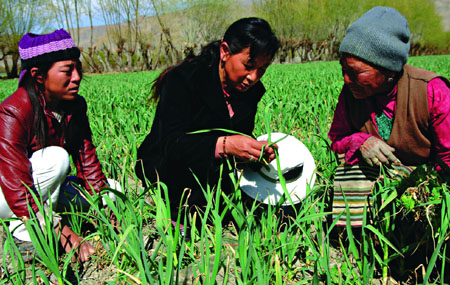| In 2006, not only did Tibet make much headway in introducing, assimilating and popularizing advanced applicable technologies, but also strengthened its independent research and developing ability. Science and technologies played a much more important role in supporting and leading economic construction and social development. The year saw Tibetan research specialist staff undertake 25 State scientific and technological programs and 121 key scientific and technological programs at autonomous region level, with 28 items of scientific and technological achievement above provincial and ministry level. In addition, it submitted 89 patent applications, 81 of which were authorized.

Tibet pays high attending to introducing and applying advanced agro-technology. Picture shows agro-technician from Nedong (middle) giving guidance to local farmers.
International science and technology cooperation is an important part of Tibet's scientific and technological work. Recent years have seen great progress made by Tibet in this regard. Currently, Tibet has set up science and technology exchanges and cooperative relationships with 10 countries, signing many agreements. From 2001 to 2005, more than 30 science and technology groups were sent overseas, with 240-plus person times taking part in international academic conferences on science and technology and conducting cooperative research, and so on. At the same time, Tibet invited some 50 groups of foreign experts and scholars, totaling 350 person times. It also hosted 135 groups of foreign scientific investigation groups with over 810 person times. The international scientific and technology cooperation developed into the more substantial cooperative research, exchanges of scholars and cooperative development, and so on.
Thus far, Tibet has set up 41 weather stations, four meteorological observatories with radar installations, seven cloud map receiving stations, eight seismic station and 28 water monitoring stations.
|





